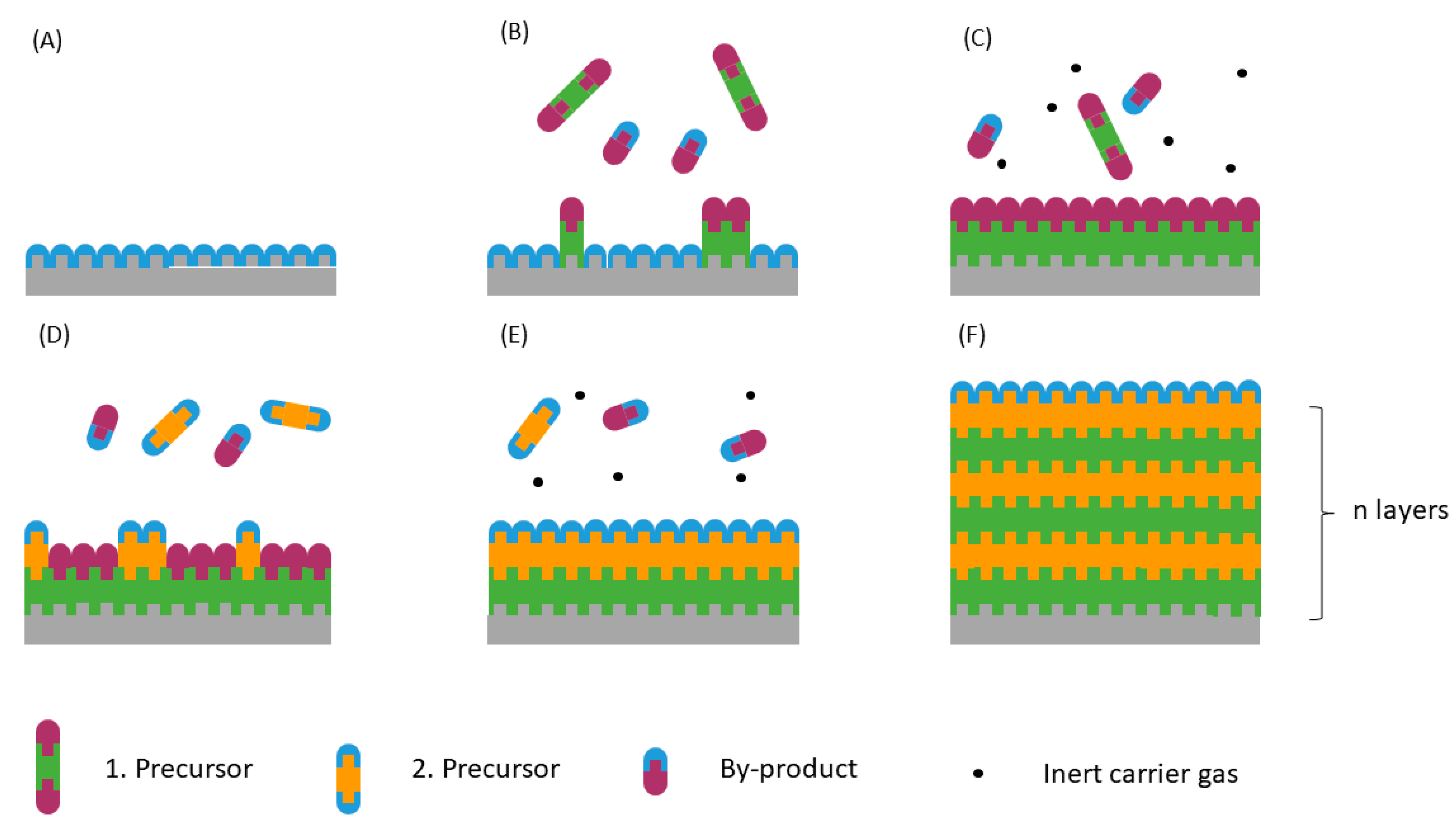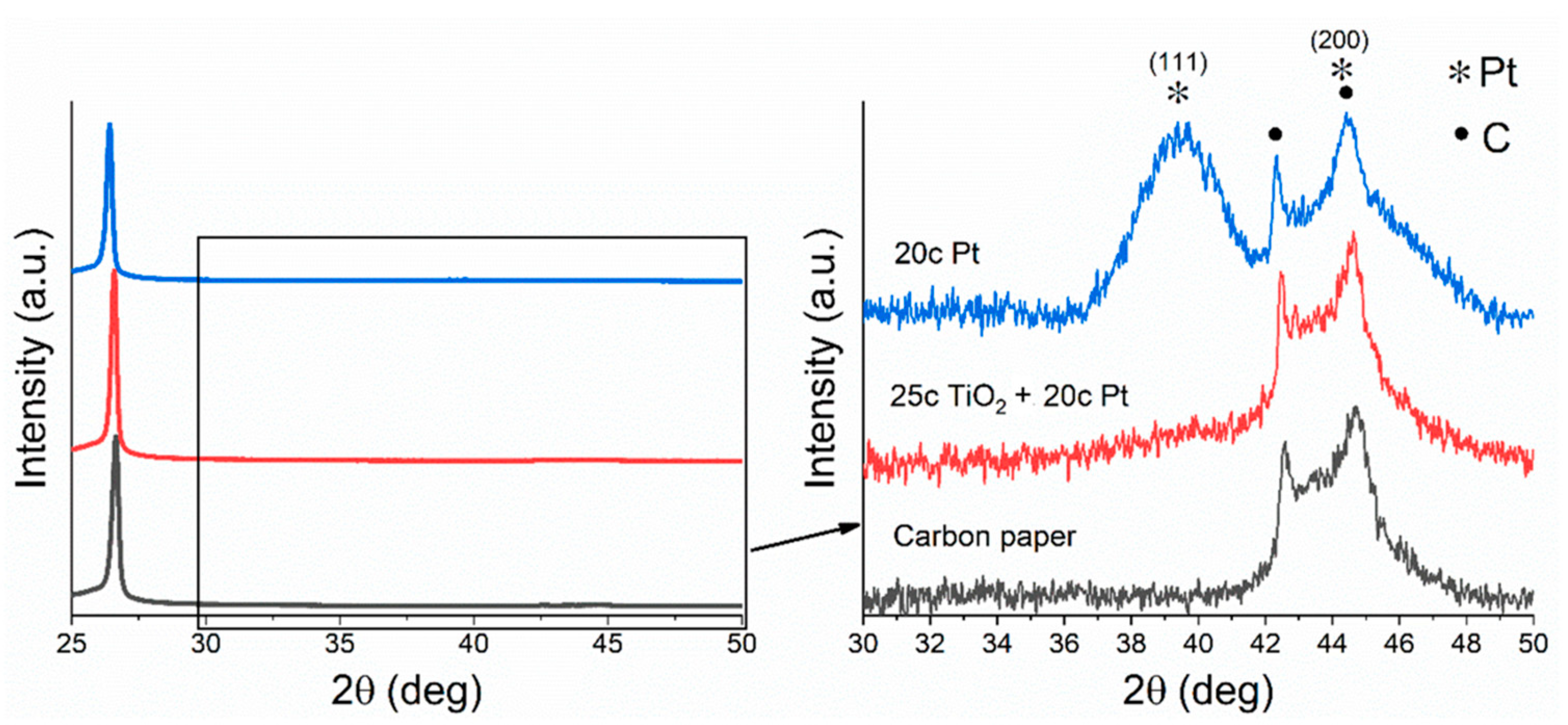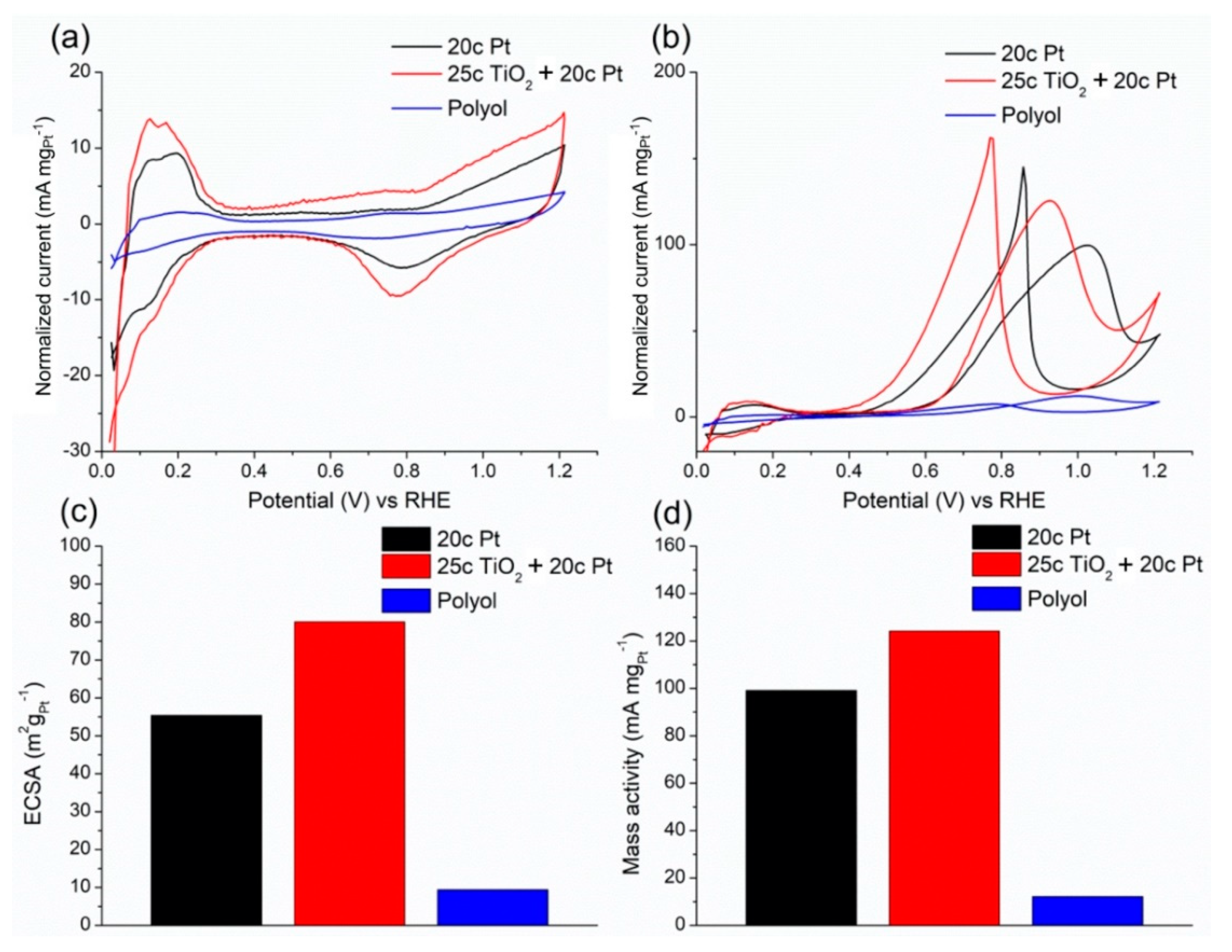Binder-Free Construction of a Methanol Tolerant Pt/TiO2/Carbon Paper Anode by Atomic Layer Deposition
Abstract
1. Introduction
2. Results and Discussion
2.1. Morphology
2.2. Structure and Composition
2.3. Electrocatalytic Measurements
3. Materials and Methods
3.1. Catalyst/Electrode Characterisation
3.2. Electrochemical Measurements
4. Conclusions
Supplementary Materials
Author Contributions
Funding
Data Availability Statement
Conflicts of Interest
References
- Ong, B.C.; Kamarudin, S.K.; Basri, S. Direct liquid fuel cells: A review. Int. J. Hydrog. Energy 2017, 42, 10142–10157. [Google Scholar] [CrossRef]
- Saurat, M.; Bringezu, S. Platinum group metal flows of Europe, part I: Global supply, use in industry, and shifting of environmental impacts. J. Ind. Ecol. 2008, 12, 754–767. [Google Scholar] [CrossRef]
- Chrzanowski, W.; Wieckowski, A. Surface structure effects in platinum/ruthenium methanol oxidation electrocatalysis. Langmuir 1998, 14, 1967–1970. [Google Scholar] [CrossRef]
- Kadirgan, F.; Beden, B.; Leger, J.M.; Lamy, C. Synergistic effect in the electrocatalytic oxidation of methanol on platinum+palladium alloy electrodes. J. Electroanal. Chem. Interfacial Electrochem. 1981, 125, 89–103. [Google Scholar] [CrossRef]
- Xu, J.; Liu, X.; Chen, Y.; Zhou, Y.; Lu, T.; Tang, Y. Platinum-Cobalt alloy networks for methanol oxidation electrocatalysis. J. Mater. Chem. 2012, 22, 23659–23667. [Google Scholar] [CrossRef]
- Zaidi, S.M.J.; Rauf, M.A. Fuel Cell Fundamentals; Wiley: Hoboken, NJ, USA, 2009; ISBN 9780387735313. [Google Scholar]
- Hua, H.; Hu, C.; Zha, Z.; Liu, H.; Xie, X.; Xi, Y. Pt nanoparticles supported on submicrometer-sized TiO2 spheres for effective methanol and ethanol oxidation. Electrochim. Acta 2013, 105, 130–136. [Google Scholar] [CrossRef]
- Wang, Y.; Mohamedi, M. Hierarchically organized nanostructured TiO2/Pt on microfibrous carbon paper substrate for ethanol fuel cell reaction. Int. J. Hydrog. Energy 2017, 42, 22796–22804. [Google Scholar] [CrossRef]
- Abdullah, N.; Kamarudin, S.K. Titanium dioxide in fuel cell technology: An overview. J. Power Sources 2015, 278, 109–118. [Google Scholar] [CrossRef]
- Lasch, K.; Jörissen, L.; Garche, J. Effect of metal oxides as co-catalysts for the electro-oxidation of methanol on platinum-ruthenium. J. Power Sources 1999, 84, 225–230. [Google Scholar] [CrossRef]
- Stepanov, A.L.; Golubev, A.N.; Nikitin, S.I.; Osin, Y.N. A review on the fabrication and properties of platinum nanoparticles. Rev. Adv. Mater. Sci. 2014, 38, 160–175. [Google Scholar]
- Islam, M.A.; Bhuiya, M.A.K.; Islam, M.S. A Review on Chemical Synthesis Process of Platinum Nanoparticles. Asia Pac. J. Energy Environ. 2014, 1, 101–114. [Google Scholar] [CrossRef]
- Bodner, M.; García, H.R.; Steenberg, T.; Terkelsen, C.; Alfaro, S.M.; Avcioglu, G.S.; Vassiliev, A.; Primdahl, S.; Hjuler, H.A. Enabling industrial production of electrodes by use of slot-die coating for HT-PEM fuel cells. Int. J. Hydrog. Energy 2019, 44, 12793–12801. [Google Scholar] [CrossRef]
- Morgan, R.D.; Haan, J.L.; Masel, R.I. Effects of Nafion loading in anode catalyst inks on the miniature direct formic acid fuel cell. J. Power Sources 2010, 195, 6405–6410. [Google Scholar] [CrossRef]
- Sasikumar, G.; Ihm, J.W.; Ryu, H. Optimum Nafion content in PEM fuel cell electrodes. Electrochim. Acta 2004, 50, 601–605. [Google Scholar] [CrossRef]
- Tu, H.C.; Wang, W.L.; Wan, C.C.; Wang, Y.Y. Novel method for the synthesis of hydrophobic Pt-Ru nanoparticles and its application to preparing a Nafion-free anode for the direct methanol fuel cell. J. Phys. Chem. B 2006, 110, 15988–15993. [Google Scholar] [CrossRef]
- Xu, H.; Reunchan, P.; Ouyang, S.; Tong, H.; Umezawa, N.; Kako, T.; Ye, J. Anatase TiO2 single crystals exposed with high-reactive {111} facets toward efficient H2 evolution. Chem. Mater. 2013, 25, 405–411. [Google Scholar] [CrossRef]
- Cheng, N.; Shao, Y.; Liu, J.; Sun, X. Electrocatalysts by atomic layer deposition for fuel cell applications. Nano Energy 2016, 29, 220–242. [Google Scholar] [CrossRef]
- Yan, H.; Cheng, H.; Yi, H.; Lin, Y.; Yao, T.; Wang, C.; Li, J.; Wei, S.; Lu, J. Single-Atom Pd1/Graphene Catalyst Achieved by Atomic Layer Deposition: Remarkable Performance in Selective Hydrogenation of 1,3-Butadiene. J. Am. Chem. Soc. 2015, 137, 10484–10487. [Google Scholar] [CrossRef]
- Gould, T.D.; Lubers, A.M.; Corpuz, A.R.; Weimer, A.W.; Falconer, J.L.; Medlin, J.W. Controlling nanoscale properties of supported platinum catalysts through atomic layer deposition. ACS Catal. 2015, 5, 1344–1352. [Google Scholar] [CrossRef]
- Yang, H.; Chen, Y.; Qin, Y. Application of atomic layer deposition in fabricating high-efficiency electrocatalysts. Chin. J. Catal. 2020, 41, 227–241. [Google Scholar] [CrossRef]
- Deng, J.; Zhang, J.; Chen, J.; Luo, Y.; Chen, Y.; Xue, Y.; Wang, G.; Wang, R. Fabrication of layered porous TiO2/carbon fiber paper decorated by Pt nanoparticles using atomic layer deposition for efficient methanol electro-oxidation. J. Electroanal. Chem. 2020, 148, 114468. [Google Scholar] [CrossRef]
- Frelink, T.; Visscher, W.; van Veen, J.A.R. Particle size effect of carbon-supported platinum catalysts for the electrooxidation of methanol. J. Electroanal. Chem. 1995, 382, 65–72. [Google Scholar] [CrossRef]
- Manoharan, R.; Goodenough, J.B. Methanol oxidation in acid on ordered NiTi. J. Mater. Chem. 1992, 2, 875–887. [Google Scholar] [CrossRef]
- Te Hsieh, C.; Tzou, D.Y.; Jiang, M.T. Methanol electro-oxidation on Pt nanocatalysts prepared by atomic layer deposition. J. Electroanal. Chem. 2017, 794, 139–147. [Google Scholar] [CrossRef]
- Hofstead-Duffy, A.M.; Chen, D.J.; Sun, S.G.; Tong, Y.J. Origin of the current peak of negative scan in the cyclic voltammetry of methanol electro-oxidation on Pt-based electrocatalysts: A revisit to the current ratio criterion. J. Mater. Chem. 2012, 22, 5205–5208. [Google Scholar] [CrossRef]
- Chung, D.Y.; Lee, K.J.; Sung, Y.E. Methanol electro-oxidation on the Pt surface: Revisiting the cyclic voltammetry interpretation. J. Phys. Chem. C 2016, 120, 9028–9035. [Google Scholar] [CrossRef]
- Kuriganova, A.B.; Leontyev, I.N.; Alexandrin, A.S.; Maslova, O.A.; Rakhmatullin, A.I.; Smirnova, N.V. Electrochemically synthesized Pt/ TiO2-C catalysts for direct methanol fuel cell applications. Mendeleev Commun. 2017, 27, 67–69. [Google Scholar] [CrossRef]
- Bedolla-Valdez, Z.I.; Verde-Gómez, Y.; Valenzuela-Muñiz, A.M.; Gochi-Ponce, Y.; Oropeza-Guzmán, M.T.; Berhault, G.; Alonso-Núñez, G. Sonochemical synthesis and characterization of Pt/CNT, Pt/TiO2, and Pt/CNT/TiO2 electrocatalysts for methanol electro-oxidation. Electrochim. Acta 2015, 186, 76–84. [Google Scholar] [CrossRef]
- Wu, X.; Zhuang, W.; Lu, L.; Li, L.; Zhu, J.; Mu, L.; Li, W.; Zhu, Y.; Lu, X. Excellent performance of Pt-C/TiO2 for methanol oxidation: Contribution of mesopores and partially coated carbon. Appl. Surf. Sci. 2017, 426, 890–896. [Google Scholar] [CrossRef]
- Zhuang, W.; He, L.; Zhu, J.; An, R.; Wu, X.; Mu, L.; Lu, X.; Lu, L.; Liu, X.; Ying, H. TiO2 nanofibers heterogeneously wrapped with reduced graphene oxide as efficient Pt electrocatalyst supports for methanol oxidation. Int. J. Hydrog. Energy 2015, 40, 3679–3688. [Google Scholar] [CrossRef]
- Monshi, A.; Foroughi, M.R.; Monshi, M.R. Modified Scherrer Equation to Estimate More Accurately Nano-Crystallite Size Using XRD. World J. Nano Sci. Eng. 2012, 2, 154–160. [Google Scholar] [CrossRef]
- Chaiburi, C.; Hacker, V. Catalytic activity of various platinum loading in acid electrolyte at 303 K. Energy Procedia 2017, 138, 229–234. [Google Scholar] [CrossRef]
- Pozio, A.; De Francesco, M.; Cemmi, A.; Cardellini, F.; Giorgi, L. Comparison of high surface Pt/C catalysts by cyclic voltammetry. J. Power Sources 2002, 105, 13–19. [Google Scholar] [CrossRef]
- Trasatti, S.; Petrii, O.A. International Union of Pure and Applied Chemistry Physical Chemistry Division Commission on Electrochemistry: Real Surface Area Measurements in Electrochemistry. Pure Appl. Chem. 1991, 63, 711–734. [Google Scholar] [CrossRef]
- Sarma, L.S.; Taufany, F.; Hwang, B.J. Electrocatalyst Characterization and Activity Validation—Fundamentals and Methods. In Electrocatalysis of Direct Methanol Fuel Cells: From Fundamentals to Applications; Wiley: Hoboken, NJ, USA, 2009; pp. 115–163. [Google Scholar] [CrossRef]




| Catalyst | if/ib | Scan Rate (mV s−1) | Reference |
|---|---|---|---|
| 20c Pt | 0.69 | 10 | This work |
| 25c TiO2 + 20c Pt | 0.78 | 10 | This work |
| Pt/TiO2-C 10% TiO2 | 0.84 | 20 | [28] |
| Pt/TiO2-C 30% TiO2 | 0.81 | 20 | [28] |
| Pt/TiO2-C 60% TiO2 | 0.78 | 20 | [28] |
| Pt/TiO2 | 1.21 | 20 | [29] |
| Pt/CNT | 0.89 | 20 | [29] |
| Pt/CNT/TiO2 | 0.99 | 20 | [29] |
| Pt-TiO2 | 1.88 | 50 | [30] |
| Pt-C/TiO2 | 1.29 | 50 | [30] |
| Pt-C | 0.83 | 50 | [30] |
| Pt/TiO2-rGO | 1.17 | 50 | [31] |
Publisher’s Note: MDPI stays neutral with regard to jurisdictional claims in published maps and institutional affiliations. |
© 2021 by the authors. Licensee MDPI, Basel, Switzerland. This article is an open access article distributed under the terms and conditions of the Creative Commons Attribution (CC BY) license (http://creativecommons.org/licenses/by/4.0/).
Share and Cite
Ballai, G.; Gyenes, T.; Haspel, H.; Vásárhelyi, L.; Szenti, I.; Sebők, D.; Kónya, Z.; Kukovecz, Á. Binder-Free Construction of a Methanol Tolerant Pt/TiO2/Carbon Paper Anode by Atomic Layer Deposition. Catalysts 2021, 11, 154. https://doi.org/10.3390/catal11020154
Ballai G, Gyenes T, Haspel H, Vásárhelyi L, Szenti I, Sebők D, Kónya Z, Kukovecz Á. Binder-Free Construction of a Methanol Tolerant Pt/TiO2/Carbon Paper Anode by Atomic Layer Deposition. Catalysts. 2021; 11(2):154. https://doi.org/10.3390/catal11020154
Chicago/Turabian StyleBallai, Gergő, Tamás Gyenes, Henrik Haspel, Lívia Vásárhelyi, Imre Szenti, Dániel Sebők, Zoltán Kónya, and Ákos Kukovecz. 2021. "Binder-Free Construction of a Methanol Tolerant Pt/TiO2/Carbon Paper Anode by Atomic Layer Deposition" Catalysts 11, no. 2: 154. https://doi.org/10.3390/catal11020154
APA StyleBallai, G., Gyenes, T., Haspel, H., Vásárhelyi, L., Szenti, I., Sebők, D., Kónya, Z., & Kukovecz, Á. (2021). Binder-Free Construction of a Methanol Tolerant Pt/TiO2/Carbon Paper Anode by Atomic Layer Deposition. Catalysts, 11(2), 154. https://doi.org/10.3390/catal11020154








